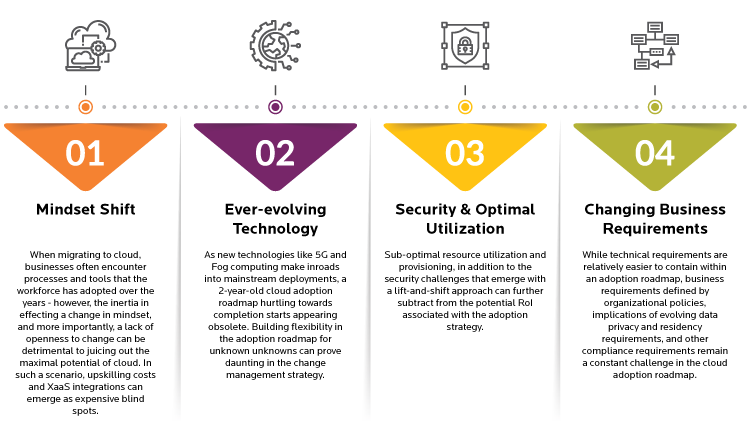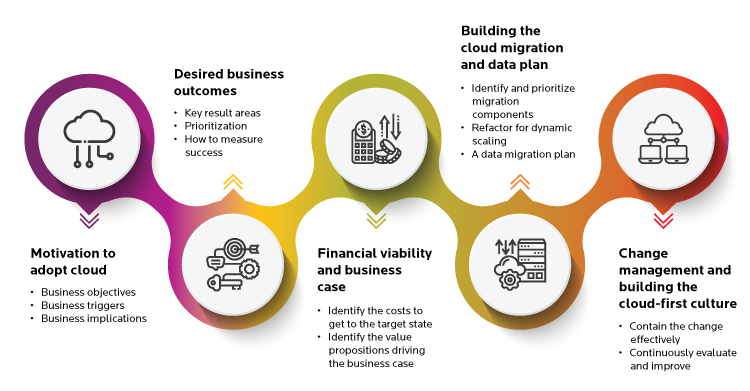Here are two critical ones:
- The business: As businesses go global and grow in size and complexity in an environment that challenges the first principles of transportation and how work happens behind the scenes (in offices), the cloud is becoming necessary for continuity and survival. It is no surprise that top cloud service providers experienced the fastest growth in demand during the pandemic. Moreover, the ability to stay resilient to changing demand and respond with effortlessly scalable and flexible infrastructure has become a deciding factor in staying profitable.
- The end-user: As customer expectations are skyrocketing, companies across industries are finding it difficult to stay responsive and deliver services with uniform experience levels round the clock without a solid cloud infrastructure backing up their operations.
Challenges in Cloud Adoption
While cloud adoption has sped up over the last year, the challenges of bringing cost-competitiveness and targeting the right outcomes have not faded away. Here are the top challenges experienced by businesses and their CIOs in their cloudification initiatives:
- Mindset Shift: When migrating to the cloud, businesses often encounter processes and tools that the workforce has adopted over the years - however, the inertia in effecting a change in mindset, and more importantly, a lack of openness to change can be detrimental to juicing out the maximal potential of the cloud. In such a scenario, upskilling costs and XaaS integrations can emerge as expensive blind spots.
- Ever-evolving Technology: As new technologies like 5G and Fog computing make inroads into mainstream deployments, a 2-year-old cloud adoption roadmap hurtling towards completion starts appearing obsolete. Building flexibility in the adoption roadmap for unknown unknowns can prove daunting in the change management strategy.
- Security & Optimal Utilization: Sub-optimal resource utilization and provisioning, in addition to the security challenges that emerge with a lift-and-shift approach, can further subtract from the potential RoI associated with the adoption strategy.
- Changing business requirements: While technical requirements are relatively easier to contain within an adoption roadmap, business requirements defined by organizational policies, implications of evolving data privacy and residency requirements, and other compliance requirements remain a constant challenge in the cloud adoption roadmap.

Challenges in Cloud Adoption Strategy
Cloud Adoption Strategic Guiding Principles
To pinpoint the cloud adoption roadmap to the desired outcomes, businesses must strategize and follow five principles.
#1 Motivation to adopt cloud
CIOs are often subject to significant fog due to myths surrounding the incentives that prompt the move to the cloud. For example, the belief that the move from Capex to Opex is inherently profitable, or a lift-and-shift approach will bring better RoI than the current on-prem configurations, or all the workloads must move to the cloud - can set the cloud adoption strategy towards failure from the get-go. Instead, CIOs must identify:
- Business objectives: These can be critical business needs like the necessity to reduce IT disruptions, delivering more than just meeting SLAs, fulfilling compliance requirements, reducing capital expenses, building dynamic scalability to respond to demand fluctuations, or reducing complexity in the vendor/partner ecosystem.
- Business triggers: These can result from plans to launch a new global service/product or the introduction of new regulations that have implications on your current infrastructure configurations. Moreover, the necessity to migrate can also be triggered by a change in the operating model or adoption of a new business model.
- Business Implications: Lastly, CIOs must understand the peripheral changes that must be effected to transform happen. For example, how will the current workforce align with the new infrastructure configuration, and how will new roles map in the target operating model? Which workloads need to be migrated, and how will the approach to cybersecurity change when moving away from private datacenters? Once the motivations for cloud adoption have been identified, businesses must envision a target state which can help them achieve the desired outcomes.
#2 Desired business outcomes
While mapping the desired outcomes in the target state will inform the sequence in which the right levers will be engaged in the cloud adoption roadmap, CIOs must also maintain realistic expectations regarding RoI and migration/transformation timelines. Lastly, the right metrics for measuring the target state's outcomes must also be identified in the cloud adoption game plan.
- Key result areas: While the cloud can help organizations achieve over 70% reduction in IT issues, improve productivity by 38% and reduce downtime by multiple factors, businesses must identify the key result areas in line with their incentives to move to the cloud the larger business strategy. In this process, IT architects and product owners must be engaged to identify the target configuration, performance bottlenecks, and baseline changes necessary to move workloads to the cloud.
- Prioritization: Once the key result areas have been identified, the right prioritization can make or break the RoI on the transformation. For example, on discovering an untapped customer segment and the consequent need to modernize their application target this segment, a logistics company identified that an early mover advantage could lend it a strategically advantageous place in the market compared to its competitor. In achieving such time-bound transformations, bandwidth, testing, and migration timelines play a major role.
- How to measure success: Will the target state measure success in productivity boosts or cost reductions? How will the productivity boost be measured? For example, if enhanced CX is a major motivation informing cloud adoption, then mean resolution time (MTR) or time to resolve (TTR) must see improvements. Keep the KPIs as close to the end-point of the process that you seek to improve.
#3 Financial viability and business case
A cloud adoption strategy will be incomplete without a solid business case that is financially viable to the company. Here are three steps to build one:
Identify the costs to get to the target state
Moving to the cloud will redefine how the IT budget will be consumed in the target state. Beyond the compute, storage, and networking costs, CIOs must identify the costs associated with upskilling the workforce to support the target configuration, system integrations and accounting, and financial boundaries that will guard-rail the costs in the target state.
Identify the value propositions driving the business case:
Beyond a solid understanding of how the migration will free up funds for the enterprise, CIOs must never lose sight of the central value propositions, like the RoI on the transformation, and business-level incentives that raised the question of cloud adoption in the first place: like the cost-benefits associated with reduced complexity or the ability to introduce innovative products and services and how they will influence the overall revenue on a product/service. Leveraging tools that are native to the chosen cloud service provider can help CIOs make reasonably accurate estimates from the get-go.





